
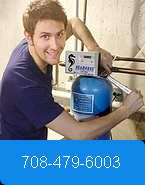
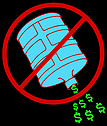
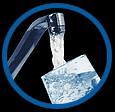
Drinking water is tastier ... coffee, tea, juice, ice, & cooking are better with our home purifying systems.
Reverse Osmosis will run circles around those pour-through pitchers and snap-on faucet filters. Why waste money
on toys that will never even come close to this level of pure water filtration.
Reverse osmosis (RO) is the most economical method of removing 90% to 99% of all contaminants and impurities. The pore structure of RO
membranes is much tighter than UF membranes. They are capable of rejecting practically all particles, bacteria and organics >300 daltons
molecular weight (including pyrogens). In fact, reverse osmosis technology is used by most leading water bottling plants.
Natural osmosis occurs when solutions with two different concentrations are separated by a semi-permeable membrane. Osmotic pressure drives
water through the membrane; the water dilutes the more concentrated solution; and the end result is an equilibrium of pure quality water.
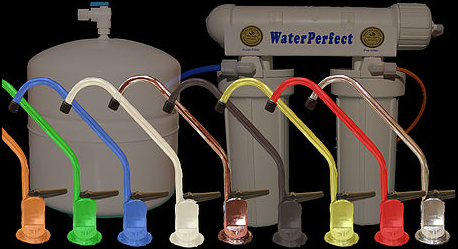
System Capacity ……..............…. 16-18 gallons per day
Pressure Tank Capacity.......................... 3.2-20 gallons
Filtration ………………............................... Finest available
Pre-Filter Cartridge ……................ Extra-fine micron-10"
Post-Filter Cartridge .................... Activated Carbon-10"
Available Membrane ................. Cellulose Tri-Acitate-CTA
Available Membrane ................ Thin Film Composite-TFC
Total Dissolved Solids ... 1200 ppm CTA-2000 ppm-TFC
Height.................... ......... Stage III-16"/Stage IV-16 ½"
Depth .................................. Stage III-13"/Stage IV-15"
Weight .......................... Stage III-25lbs./Stage IV-30lbs
Faucet ........................................................ 7½" height
Feed ........................................................ Potable water
In Line Filters .................... Granulated Activated Carbon
PRESSURE CTA membrane 40-100 psi
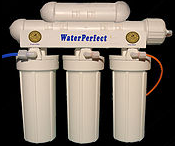 TFC membrane 40-100 psi
TFC membrane 40-100 psi
TEMPERATURE CTA membrane 40-90 F°
TFC membrane 40-120°
Operation Maintenance and Replacement Requirements are Necessary to Perform to Specifications.
Several models & styles to accommodate all types of water
Are you "sick" of drinking that old tap water? Enjoy amazingly clean, pure, safe reverse osmosis water.
Reverse osmosis and activated carbon filtration are complementary processes. Combining them results in the most effective treatment against the
broadest/range of water impurities and contaminants. Our RO systems incorporate both a pre-filter, and an activated carbon post-filter. The
average size of the openings between pieces of the filter media are represented in microns. For example, a 10-micron filter has larger openings
than a 5-micron filter. Consequently, the 10-micron filter element will let larger particles pass through the filter than the 5-micron element. In other
words, the smaller the micron rating the finer it can filter.

Four stage filtration process
• Stage 1: sediment & rust filtration
• Stage 2: activated carbon filtration
• Stage 3: reverse osmosis membrane
• Stage 4: final activated carbon polishing filtration production rate of up to18 gallons per day 3.2 gallon tank.
High flux, thin film composite RO membrane Water storage capacity: 3.2 gallons Max water temperature: 100°F Min water pressure: 40 PSI Max
water pressure: 100PSI
F.A.Q. by moms:
Does R. O. remove fluoride. Yes but dentists will tell you that on average, consuming fluoride doesn't benefit people after the age of 16 -18.
Dentists also tell us that the fluoride contained in most tooth paste is more that sufficient to protect children's teeth but the bottom line... fluoride
has now been linked to cancer.
Rejection Rates by Reverse Osmosis
Arsenic (poison).........................................95-97%
Ammonium..................................................85-95%
Chlorine (considered carcinogenic)............90-95%
Chromium (Chicago water carcinogen)......95-98%
Sodium (salt)..............................................94-98%
Phosphate..................................................97-98%
Magnesium.................................................95-98%
Cyanide (poison)........................................90-95%
Potassium...................................................94-97%
Magnesium.................................................97-98%
Thiosulfate..................................................97-98%
Iron.............................................................97-98%
Silicate........................................................94-96%
Aluminum....................................................97-98%
Silica...........................................................80-90%
Copper.......................................................97-98%
Radium................................. (and forms of Radon)
Chicago & city water smell ......(common complaint)
Nitrate.........................................................92-95%
Nickel..........................................................97-98%
Boron..........................................................60-70%
Silver...........................................................95-97%
Fluoride..............(believed toxic & can promote fat)
Polyphosphate............................................98-99%
Mercury.......................................................95-97%
Orthophosphate..........................................98-99%
Hardness Ca & Mg......................................95-98%
Chromate....................................................90-97%
Rodioactivity................................................90-97%
Chloride.......................................................90-95%
Lead............................................................96-98%
Organic Pesticides.......................................95-98%
Microscopic parasites & many other contaminants + PCB's
The above percent of rejection uses a TFC membrane and is for
reference and not to be construed as any guarantee since the chemistry,
temperature and TDS are not consistent in each water supply.
Whole House Reverse Osmosis
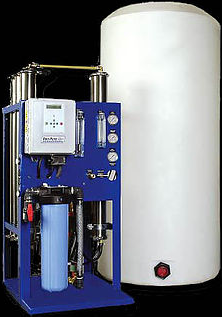
List of Chemical Contaminants Which R. O. Filters Can Remove
Chemicals
Acetaldehyde
Acetic Acid
Acetone
Alcohols
Amines
Amyl Acetate
Amyl Alcohol
Antifreeze
Benzene
Bleach
Butyl Alcohol
Butyl Acetate
Calcium Hypochlorite
Chloral
Chloamine
Chloroform
Chlorine
Chlorobenzene
Chlorophenol
Chlorophyll
Citric Acid
Cresol
Defoilants
Detergents
Diesel Fuel
Dyes
Ethyl Acetate
Ethyl Acrylate
Ethyl Alcohol
Ethyl Amine
Ethyl Chlorine
Ethyl Ether
Gasoline
Glycols
Herbicides
Hydrogen Peroxide
Hydrogen Selenide
Hydrogen Sulfide
Hypochlorous Acid
Insecticides
Iodine
Isopropyl Acetate
Isopropyl Alcohol
Ketones
Lactic Acid
Mercaptans
Methyl Acetate
Methyl Alcohol
Methyl Bromide
Methyl Chloride
Methyl Ethyl Ketone
Naphtha
Nitric Acid
Nitrobenzene
Nitrotoluene
Odors (general)
Oil Dissolved
Organic Acids
Organic Esters
Organic Salts
Oxalic Acids
PCB?s
Pesticides
Phenol
Plastic Taste
Propioic Acids
Propionaldehyde
Propyl Acetate
Propyl Acid
Propyl Chloride
Rubber Hose Taste
Soap
Sodium Hydrochorite
Solvents
Sulphonated Oils
Tannins
Tar Emulsion
Tartaric Acid
Taste (DI Water)
Taste (From Organics)
THM?s
Toluene
Toluidine
Trchlorethylene
Turpintine
Vinegar
Xanthophyll
Xylene
Organic Contaminants
2,4,5-TP(Trichlorophenoxy) propionic acid
2,4 Dichlorophenoxyacetic acid
Acrylamide
Adipates (diethylhexyl)
Alachlor
Aldicarb
Aldicarb Sulfone
Aldicarb Sulfoxide
Atazine
Benz(a)anthracene (PAH)
Benzene
Benzo(a)pyrene (PAH)
Benzo(b)fluoranthene (PAH)
Benzo(k) fluoranthene (PAH)
Bromodichloromethane
Bromoform
Butyl benzyl phthalate (PAE)
Carbofuran
Carbon Tetrachloride Chlordane
Chloroform
Chrysene (PAH)
Dalapon
Dibenz(a,h) anthracene (PAH)
Dibromochloromethane
Dibromochloropropane (DBCP)
Dichlorobenzene (o-,m-)
Dichlorobenzene (para-)
Dichloroethane (1,2-)
Dichloroethylene (1,1-)
Dichloroethylene (cis-1,2-)
Dichloroethylene (trans-1,2-)
Dichloromethane (methylene chloride)
Dichloropropane (1,2-)
Diethylhexyl phthalate (PAE)
Dinoseb
Diquat
Endothall
Endrin
Epichlorohydrin
Ethylbenzene
Ethylene dibromide (EDB)
Glyphosate
Heptachlor
Heptachlor epoxide
Hexachlorobeneze
Hexachlorocyclopentadiene
Indeno (1,2,3-c,d) pyrene (PAH)
Lindane
Methoxychlor
Monochlorobenzene
Oxamyl (vydate)
Pentachlorophenol
Picloram
Polychlorinated byphenyls (PCBS)
Simazine
Styrene
Tetrachloroethylene
Toluene
Toxaphene
Trichlorobenzne (1,2,4)
Trichloroethane (1,1,1-)
Trichloroethylene
Trichloroethylene (1,1,2-)
Trihalomethanes (THMs)
Vinyl Chloride
Xylene (total)
2,3,7,8-TCDD Tetrachlorodibenzo-p-Dioxin



